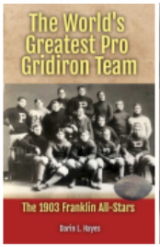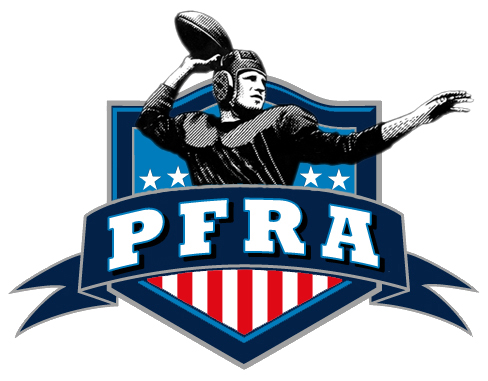Born June 17, 1886, in Chicago, Illinois, was the University of Chicago quarterback of the 1903 to 1906 era, Walter Eckersall. Walter played for legendary Maroon Coach Amos Alonzo Stagg at the University of Chicago. Walter was a quick and very elusive runner and an exceptional kicker. It was his coffin-corner punts which were credited as the death-blows to Michigan's 56-game winning streak when the Maroons downed the Wolverines, 2-0, in 1905. Eckersall made quite an impression on a young Knute Rockne, as he was one of the future coaches gridiron heroes growing up that gave him inspiration. "The first time I learned a football was not only something to kick, but something to think with, was when I saw a great football player in action for the first time." said Rockne according to the FootballFoundation.org when reminiscing of observing Eckersall. Rockne had seen the great Chicago quarterback playing in a high school all-star game in 1900. A decade or two later, after Rockne became the head coach at Notre Dame, Knute discovered Eckersall was scheduled to officiate an Irish game in Chicago. "I've been waiting years for this," Rockne said to Eckersall. "For what?" Eckersall wanted to know. "To shake your hand.", Rockne blurted, quick to relay his memories of that high school all-star game so many years before. "Stop! Stop!", Eckersall interrupted, "Or Notre Dame will be penalized five yards for speech making." Rockne enjoyed recanting that story of meeting his childhood icon for the rest of his life. The legendary Walter Camp even selected Eckersall as the QB on the All-Time All- American Football Team that honored the players from the first 3 to four decades of football. Walter Eckersall was inducted into the College Football Hall of Fame in 1951 for his outstanding play as a quarterback. Our friend author Jennifer Taylor Hall who wrote her amazing book Amos Alonzo Stagg: College Football's Man in Motion shares in her chapter on "Eckie" that after Walter's playing days the former QB officiated football, was a sports writer for the Chicago Tribune and often was a publicist for Knute Rockne.
Football History
Walter Eckersall
The 1922 Rose Bowl
Celebrate 2 of the top Gridiron Coaches in history in the latest Pigskin Dispatch book When Greasy Met the Wonder Coach
Greatest Pro Team
Who was the MOST DOMINANT team in Pro Football History? We have the answer in the latest Pigskin Dispatch book The World's Greatest Pro Gridiron Team
FREE Daily Sports History
You are only seconds away from receiving the Pigpen's Newsletter everyday filled with new items
SUBSCRIBE BY CLICKING
_________________________
COLLEGE HOF | ‣
Walter Eckersall
Born June 17, 1886, in Chicago, Illinois, was the University of Chicago quarterback of the 1903 to 1906 era, Walter Eckersall. Walter played for legendary Maroon Coach Amos Alonzo Stagg at the University of Chicago.
Walter was a quick and very elusive runner and an exceptional kicker. It was his coffin-corner punts which were credited as the death-blows to Michigan's 56-game winning streak when the Maroons downed the Wolverines, 2-0, in 1905. Eckersall made quite an impression on a young Knute Rockne, as he was one of the future coaches gridiron heroes growing up that gave him inspiration. "The first time I learned a football was not only something to kick, but something to think with, was when I saw a great football player in action for the first time." said Rockne according to the FootballFoundation.org when reminiscing of observing Eckersall.
Rockne had seen the great Chicago quarterback playing in a high school all-star game in 1900. A decade or two later, after Rockne became the head coach at Notre Dame, Knute discovered Eckersall was scheduled to officiate an Irish game in Chicago. "I've been waiting years for this," Rockne said to Eckersall. "For what?" Eckersall wanted to know. "To shake your hand.", Rockne blurted, quick to relay his memories of that high school all-star game so many years before. "Stop! Stop!", Eckersall interrupted, "Or Notre Dame will be penalized five yards for speech making." Rockne enjoyed recanting that story of meeting his childhood icon for the rest of his life. The legendary Walter Camp even selected Eckersall as the QB on the All-Time All- American Football Team that honored the players from the first 3 to four decades of football. Walter Eckersall was inducted into the College Football Hall of Fame in 1951 for his outstanding play as a quarterback. Our friend author Jennifer Taylor Hall who wrote her amazing book Amos Alonzo Stagg: College Football's Man in Motion, shares in her chapter on "Eckie" that after Walter's playing days, the former QB officiated football, was a sports writer for the Chicago Tribune and often was a publicist for Knute Rockne.
Walter was a quick and very elusive runner and an exceptional kicker. It was his coffin-corner punts which were credited as the death-blows to Michigan's 56-game winning streak when the Maroons downed the Wolverines, 2-0, in 1905. Eckersall made quite an impression on a young Knute Rockne, as he was one of the future coaches gridiron heroes growing up that gave him inspiration. "The first time I learned a football was not only something to kick, but something to think with, was when I saw a great football player in action for the first time." said Rockne according to the FootballFoundation.org when reminiscing of observing Eckersall.
Rockne had seen the great Chicago quarterback playing in a high school all-star game in 1900. A decade or two later, after Rockne became the head coach at Notre Dame, Knute discovered Eckersall was scheduled to officiate an Irish game in Chicago. "I've been waiting years for this," Rockne said to Eckersall. "For what?" Eckersall wanted to know. "To shake your hand.", Rockne blurted, quick to relay his memories of that high school all-star game so many years before. "Stop! Stop!", Eckersall interrupted, "Or Notre Dame will be penalized five yards for speech making." Rockne enjoyed recanting that story of meeting his childhood icon for the rest of his life. The legendary Walter Camp even selected Eckersall as the QB on the All-Time All- American Football Team that honored the players from the first 3 to four decades of football. Walter Eckersall was inducted into the College Football Hall of Fame in 1951 for his outstanding play as a quarterback. Our friend author Jennifer Taylor Hall who wrote her amazing book Amos Alonzo Stagg: College Football's Man in Motion, shares in her chapter on "Eckie" that after Walter's playing days, the former QB officiated football, was a sports writer for the Chicago Tribune and often was a publicist for Knute Rockne.
Celebrating the Heroes of American Football
Timothy P. Brown joins Darin Hayes to delve into the fascinating history of Walter Eckersall, a significant yet often overlooked figure in early American foo... — www.youtube.com
The podcast episode features an engaging conversation between Darin Hayes and Timothy P. Brown, centered around the intriguing figure of Walter Eckersall, a notable yet often forgotten quarterback from the early days of American football.
Eckersall is an interesting figure from the early gridiron that helped shape the game we know today in multiple facets: as a player, coach, official, and media personality.
Of course, this discussion all stems from Tim's original article titled: Booklet Review:Walter Eckersall's How to Play Football.
The audio-only podcast of the discussion can be found at: Uncovering Football's Past: The Legacy of Walter Eckersall.
Who is Walter Eckersall
Walter Eckersall was a legendary figure in early 20th-century American football. A three-time All-American quarterback for the University of Chicago, he led the Maroons to an undefeated season and the national championship in 1905, famously snapping Michigan's 56-game winning streak.
Eckersall's impact extended beyond his playing career. He became a prominent sportswriter for the Chicago Tribune and a highly respected football official, officiating numerous high-profile games. His contributions to the game earned him a place in the College Football Hall of Fame.
We have much more on this important person from football's past. For more on his story check out
Walter Eckersall" href="https://pigskindispatch.com/searchresults?q2=%22Walter+Eckersall%22">.
This Story on Walter Eckersall
The episode begins by examining how each generation of players learns the game from esteemed mentors, setting the stage for a deep dive into Eckersall's life and career. Timothy paints a vivid picture of Eckersall's time as an All-American quarterback at the University of Chicago in 1906, a period when the forward pass was just beginning to emerge. The discussion highlights how Eckersall excelled not as a passer but as a strategist and athlete, influencing the game through his understanding and adaptability.
As the conversation unfolds, Timothy reveals the duality of Eckersall’s career, transitioning from a player to a respected sports writer and referee. This unique path not only showcases Eckersall's versatility but also reflects the interconnected nature of sports media and officiating during that era. The hosts discuss how Eckersall officiated significant games, including Rose Bowls, and the trust that players and fans had in him, despite the blurred lines between his various roles. This discussion leads to a broader commentary on the evolution of the game and how the role of statistics and analysis has transformed over the years, making the past seem distant yet vital to current football narratives.
Takeaways
-Darin Hayes and Timothy P. Brown discuss the history of football and its notable figures.
-Walter Eckersall was a significant pre-forward pass quarterback and a smart strategist.
-Eckersol's dual role as a writer and referee showcases the unique blend of professions in early football.
-Timothy P. Brown emphasizes the importance of preserving football history through storytelling and research.
-The podcast highlights the evolution of football and how players adapted to new strategies over time.
-Listeners are encouraged to engage with football history through Brown's substack site, Football Archaeology.
The episode ultimately serves as a tribute to the unsung heroes of football history, encouraging listeners to delve into the past and recognize the contributions of figures like Eckersall. Tim’s insights foster a greater appreciation for the foundations of the sport and emphasize the importance of preserving its history. The rich discussion not only educates but also inspires a sense of nostalgia for football’s roots, reminding us of the diverse personalities that have shaped the game into what it is today. Each story discussed reinforces the significance of understanding football's heritage and the impact of those who came before us in the sport.
Gridiron Guru Diving Deep with Coaching Legend Walter Steffen
Who was Walter Steffen? And what did he contribute to football history? Timothy Brown of Football Archaeology joins us to answer these questions about this g... — www.youtube.com
For college football fanatics, few names inspire more reverence than Walter Steffen. A coaching giant whose legacy stretches across decades, Steffen's impact on the game is undeniable. Now, you have a chance to delve into his wisdom in a captivating video interview with Timothy Brown of FootballArchaeology.com. This exclusive conversation promises a treasure trove of insights, offering a glimpse into the mind of a true gridiron mastermind. So, buckle up and get ready to learn from a master coach as we explore Walter Steffen's storied career and the timeless knowledge he brings to the game.
-Transcription of Walter Steffen with Timothy Brown
Hello, my football friends. This is Darin Hayes of PigskinDispatch.com. Welcome once again to The Pig Pen, your portal to positive football history. And welcome to another date with Timothy P. Brown of FootballArcheology.com, where he's going to share one of his recent tidbits on some of the facets of football from yesteryear.
Tim, welcome back to The Pig Pen. Darin, thank you. Looking forward to chatting and judging you based on the quality of the questions that you asked this episode.
Oh my gosh. Okay, we're back. I will be the judge.
Folks, we are back to the dad joke segues. We've had some quizzes lately and some factoids, but now we are back to Tim Brown and his finest segueing into an article that you wrote not too long ago, titled Judging Walter Steffen's Coaching Career. So Walter Steffen is an interesting figure indeed in football history.
So what do you get on him, Tim? Yeah, so, you know, you and I were talking a little bit before we started the episode proper. And, you know, Steffen is just one of these guys, and it's a name that I kept coming across over and over again. And I was just like, sometimes I got to, you know, kind of look into this guy and figure out what he was about.
And he turned out to just be this really interesting character that just is impossible to imagine today. Right? I mean, he just lived a life that no one can live anymore, not at the major college level.
You could do it at D3, which is probably the right situation, but in high schools, you know, but not at the major college level. So, I mean, you know, he really, you know, kind of a classic guy.
He grew up in Chicago, you know, 1880s, 1890s. He ends up at the University of Chicago as a freshman in the fall of 1905. So he's playing for, you know, the famous Alonzo Stagg.
So, he's on, you know, 1905, Chicago was national champs. So, he's in a pretty major deal as far as, you know, football is concerned. In 1906, Walter Eckersall was the All-American quarterback at Chicago.
So, Steffen is the, you know, second fiddle running at halfback. But then Eckersall graduates, if he graduated. He wasn't much of a student, but anyways, he leaves.
Steffen became a quarterback in his last two years, and he became an All-American quarterback as well. So, and this is him carrying the ball back here. I see the only guy without any head protection.
Yeah, and so, I may actually have the wrong image up there. Anyways, but he played in that era. So, Steffen is hanging out around Chicago.
He goes, he was unlike Eckersall. He was an excellent student and went to the University of Chicago Law School. While he's going to law school, he assists Stagg on the football team.
And so, and then, you know, he graduated from law school and worked a couple of years in the law. And, you know, it's hard to trace whether he was, you know, he may have assisted with some schools. I know he did some refereeing and things like that, which was pretty typical of the time.
But in 1914, he became the head coach at Carnegie Tech in Pittsburgh. And so, you know, he was living in Chicago. And back then, it was not uncommon at all.
There were a lot of coaches who would live in one city for nine months of the year, and then they'd go coach wherever they were coaching for the other three. And so, that's what he did. So, he hadn't, you know, he was a first; he was a Chicago alderman for a while.
He, you know, worked in different government capacities, you know, in law. And then, so, you know, he basically, in the fall, he would, he would basically move to Pittsburgh to run the team. And then, you know, probably maintain some level of practice.
But basically, you know, he'd shut down whatever his business was, you know, for those three months, and then return and, you know, work as a lawyer the rest of the year. So, in 1922, he became a Cook County judge and Chicago's in Cook County. So, what he did was he couldn't just go to Pittsburgh for three months of the year.
So, he basically stayed in Chicago, and then he would travel on the weekend to Pittsburgh if it was a home game or wherever they were playing. You know, whoever they were playing, he traveled to the game. And then there was a guy who was a former Carnegie player, I believe, but there was a guy who basically ran the show during the week, a real trusted assistant. So, and all the time that he was there, he was upgrading the schedule.
So, Carnegie had been playing, you know, kind of the smaller schools, schools are now, you know, D3 schools in, you know, Western Pennsylvania, Eastern Ohio, you know, that kind of type of school. But while he was there, he started upgrading. And so, they're playing, you know, basically a national schedule, but more, you know, like a Midwestern, you know, Midwestern schedule, mostly against, or at least a mix of kind of the smaller schools, like a lot of teams did.
And then they were playing, you know, some top talent. So, just as an example, in 26, they opened the season, they beat, you know, three lesser teams, and then they go on a run, and they beat Pitt, who has had been national champs a bunch of times by then. Detroit, who was playing, you know, pretty solid football.
West Virginia, who used to kind of not be very good, but by then was starting to, you know, come around to be a pretty good football team. And then they went, they hosted and beat a team called Notre Dame, was being coached by Newt Rockne at the time. But this is 1926.
And that was the year that, you know, Rockne and Notre Dame won the 1925 national title. So, they were big stuff. However, in 1926, Soldier Field opened in Chicago.
And that game, the stadium opened with the Army-Navy game. Well, Rockne was in Chicago for that game, while his team was in Pittsburgh, playing Carnegie Tech. And Carnegie Tech beat them.
Which was like, it was a massive, you know, massive story. I mean, the only thing that, so the Army-Navy game was just a huge story in the papers, you know, nationwide. Second to that was the fact that Carnegie Tech had beaten Notre Dame, you know, reigning national champs.
You know, which nobody had expected. So, then, to show that that wasn't just a total fluke, in 1928, Carnegie Tech went to Notre Dame. So, they go to South Bend.
And they beat Notre Dame there. So, that was Notre Dame's first loss in South Bend under Rockne. It also made Carnegie Tech and Stephan the only team or coach to beat Notre Dame twice, while Rockne was the head coach.
Other than Nebraska, under Fred Dawson, did it twice. And then Howard Jones beat Rockne at Notre Dame when he was coaching Iowa, and then twice when he was coaching USC. So, Howard Jones has won up on Walter Stephan.
But nevertheless, I mean, so it's one of these things like you hear nowadays, well, Carnegie Tech, and now it's Carnegie Mellon because, you know, the schools merged. But and you think, ah, you know, that's not big-time football. Well, it was, you know, if you beat the reigning national champ, you're playing pretty good ball, right?
And then when you beat him two years later, you're still playing pretty, pretty good ball. So, he ended up from 1922 through the 1932 season, he basically, they used to call him the commuter coach, living in Chicago, you know, take the train into whatever city they were playing in, coach him game day, and then head back, you know. And so, you know, how they kept it, how he kept in touch with the assistant who was running things day to day.
I don't know, but, you know, they did very, very well. Just, you know, another thing that was kind of fun is he was the guy who gets primarily credited with inventing the spinner play. So, you know, anybody listening, you've seen these, if you've watched any old-time football film, you've seen the spinner, where a lot of times it'll, the ball might get hiked to a quarterback, or a fullback, who's, you know, kind of, who basically catches the ball, like literally does a 360 in place, as they're faking handoffs to different people.
And then they might, you know, kind of do like a QB sort of draw, or they might run left or right, or, you know, or handoff. So, the spinner was a huge thing starting in the mid-20s when he first, you know, implemented it. And it remained in place, you know, probably mid-30s when it was dying out.
However, there are a couple of other little factoids about the spinner, such as that he first used it in 1924. And the guy who was, who ran that play, it was a guy named Dick, I've never been sure of his name, I think it's Bede, but maybe it's Bede. And he was the guy who became the Youngstown State coach.
And he's the guy who invented football's penalty flag when he was coaching Youngstown. And then people who aren't that into, you know, older football stuff, maybe recognize the fact that one of his last quarterbacks, or perhaps the last quarterback that he coached at Youngstown, was a guy named Ron Jaworski. So, anyway, that's the little tidbit on that one.
But, so then, you know, he ends up 1932, announces he's going to retire, he just can't, you know, he's starting to get a little ill, I guess, and just couldn't keep up the pace. And so, you know, he ended up with an 88-53-9 record. So, you know.
Respectable. Yeah, especially at a school like that and playing the kind of schools that he played. And then, so, 32, if people remember from an episode or two ago, that's the year Amos Alonzo Stagg is let go at Chicago.
So, he's, you know, Stefan's retiring from Carnegie Tech. So, basically, he and Fritz Kreisler were the guys everybody said, oh, they're going to use one of these, they're going to name one of these guys to replace Stagg. And instead, they brought in Clark Shaughnessy from Tulane, who was, you know, kind of the father of the modern T formation.
So, and then, unfortunately, you know, poor health, he passed away in 1937. So, he didn't get to live the good, long life that Stagg lived. But, you know, he may have been one of the last of the, you know, he was certainly one of the last of these part-time coaches at a, you know, in a major school environment at the time.
You know, probably at the time, they would have been like a G5-ish or G3 or whatever. However, there are more. You know, that level of football. And here he's a judge in Chicago, you know, lawyer, that's what he does.
You know, a couple of episodes ago, I mentioned Clarence Spears, who's a physician. There were a bunch of guys like that, you know, but he was one of the last ones who was, you know, still running a major program. And then in his case, especially, he wasn't even there, you know, during the season, you know, the commuter coach.
So, really an interesting, you know, days gone by, you know, kind of deal, yeah, just when we think that our lives are busy dealing with football on a daily basis, you have guys like him and, you know, the Paw Porners and Fielding Yost that sometimes coach multiple teams in a season and these commuter coaches and did some other full-time jobs. So, yeah, it's amazing to think about that era of football.
Yeah, I think he had five kids, too. So, you know, he was a busy man. Well, at least the chores got done at home.
I didn't have to do them all. So, that's good. Tim that is some great stuff that, you know, is a gentleman that we probably don't hear about very many places in this day and age.
And it's great to have some preservation of Mr. Stephan and his accomplishments and some of the things that he did, you know, beating Notre Dame twice and, you know, all the other things that he did, which is amazing. So, you have things like this all the time going on on footballarchaeology.com, and you share them in some little bite-sized chunks. So, maybe you could explain that to everybody and how they can enjoy it.
Sure. Just go to footballarchaeology.com, and, you know, you can subscribe. You'll get an email every time a new article is posted.
Otherwise, follow me on Twitter, on the Substack app or on threads, or just go out to Football Archaeology, you know, kind of whenever you please and see what some of the new articles are out there or check out the archives. There's a search function. Just put in a topic and see if there's something out there.
Well, sir, we thank you once again for helping us understand football of yesteryear and how it became the mega game that it is today that everybody enjoys. And it's these little pieces getting put together in a history that really make it enjoyable. And we thank you for sharing it again and we'd love to talk to you again next week.
Very good. Thank you, sir.
Transcribed by TurboScribe.ai.
Walter Eckersall Legend of the Fall - University of Chicago
A great story from the University of Chicago Magazine on the legend Walter Eckersall
Related Titles
WALTER ECKERSALL'S JOURNEY FROM PLAYER TO REFEREERelated Categories
FOOTBALL ARCHAEOLOGY, COLLEGE HOF, ABOUT SPORTSPreserving Gridiron History in a New Way!
Enjoy football history with some challenging word puzzle funThe Pigskin Dispatch Football Word Search
Proud to Support The Professional Football Researchers Association
To learn more about joining the fun in preserving football history go to The Official PFRA Website.
_________________________
We have placed some product links on this page. If you purchase by clicking on them, we will get a commission to use to help with operating costs.
Orville Mulligan: Sports Writer
We invite you to take a ride through 1920's sports history in the audio drama that takes the listener through the sounds and legendary events of the era through the eyes of a young newspaper journalist. You will feel like you were there!
Brought to you by Number 80 Productions and Pigskin Dispatch
_________________________
Gridiron Legacy: Pro Football's Missing Origin Story
Author Gregg Ficery tells the story of the beginnings of Pro Football through the pro football career of his Great Grandfather, Bob Shiring
_________________________
Sports History Network
A Proud Partner in the Headquarters of Sports Yesteryear, SHN.
_________________________
Sports Jersey Dispatch
If you like remembering players of the NFL by their numbers then you may also enjoy going uniform number by number in other team sports as well. We have it for you on our other website in baseball, basketball, hockey and more on the Sports Jersey Dispatch.
_________________________
Bears versus Cardinals: The NFL's Oldest Rivalry
Author Joe Ziemba the master historian of football in Chicago has released another beauty. It is titled Bears versus Cardinals: The NFL's Oldest Rivalry.
_________________________










